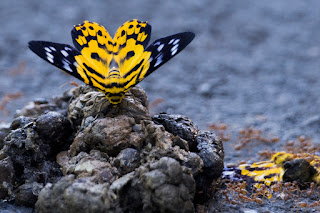Thailand
Photography Trip
This article is a second in a
series I will be doing on my recent photography trip to Thailand in
December. I want to start with some
observations made on something other than birds. On any trip in the outdoors you are bound to
encounter critters other than birds and this trip was no exception. In the Kaeng Krachan National Park we encounter
three types of monkeys besides those traveling with me. Attached is a photo of a Stub-tailed Macaque
which we observed as a part of a large group that were crossing the road. This macaque is sometimes called bear or
red-faced monkey and is endemic to South East Asia.
It can live as long as 30 years and is found
in gregarious groups of 20 to 50. Within
the group there is a strict hierarchy which is inherited from the mother, but
males must fight to retain their position.
Their diet is primarily fruits, seeds and young vegetation but they also
consume insects, birds andeggs.
A second none avian species that
got my attention was the Yellow Leopard Moth pictured here. I have tried to find more information on this
species but all I could come up with was information on the Giant Leopard Moth.
However, I decided to include it in this
article because it is such a pretty moth.
So now let’s move on to some of
the birds of Thailand. I must say we
encountered about 360 species and for the most part they were extremely
colorful as you will see from the included pictures. We first consider the Sultan Tit, an
extremely beautiful bird and one sought out by birders.
This species is one of the larger of the tit
family and is found primarily in the evergreen forest of central Thailand. It’s diet includes berries, seed, catepillers
and insects. This was the bird which my
friend Kim Risen most wanted to see during our visit.
In this same national park, Kaeng
Krachan, we also found two species of hornbills, Great and Oriental Pied. The picture included with this article is of
the Oriental Pied. Both are very large
birds with found in the canopy of tropical forest. The Oriental Pied is the smallest of the
hornbills and can be found on the Indian Subcontinent and throughout Southeast
Asia.
They feed primarily on fruits but
will also eat insects, small birds and reptiles. They are monogamous and cavity nesters, but
usually rely on cavities created by other species. One of the many birds I hoped to see on this
trip.
One afternoon we had the
opportunity to visit a photo blind where pictures of these last three species
were taken. It was located in a creek
bottom surrounded by dense forest and with a small water source provided by the
owner of the property. The water feature
was the focus of bird activity and taking a bath was their prime objective. One of the larger and more exotic species
that visited the area was the stunning Siamese Fireback Pheasant pictured
here.
This species is endemic to Indo
China, Vietnam, and eastern Thailand. It
is found in very dense forest and is usually very difficult to see. We were lucky to get a look at what is
becoming a threatened species due to hunting pressure. Note the beautiful red facial skin, bright crimson
legs and the long flowing tail. I was
excited to find this bird on the trip.
Another favorite was the Greater Ratchet-tailed
Drongo. This is only one of the seven
species of drongos found in Thailand.
Greater Ratchet-tails are the largest of the Asian drongo family.
They are found in forest settings and feed on
insects primarily but will also eat fruit, berries, and seeds. They are known to mimic calls of other
species.
And our final bird is the
Black-headed Bulbul. I must say that
bulbuls are the largest single category of birds we encountered on our trip,
second only to leaf warblers.
This bright yellow bird can be distinguished from
the similar colored species, Black-crested Bulbul, by their blue eye as well as
the lack of a crest. Like most bulbuls
they feed on small fruits, berries, and insects. They usually travel in small flocks and are
passerines, meaning they are migrants.
I want to note
that we are not far from the passerine migration we experience here in Texas
every spring. Many of our warbler
passerines are as brightly colored as those in Thailand, so be on the lookout
for them starting at the end of March.






